This is one of our all-time favourite Saturday afternoon dinners. In Norwegian it is called “Makaroni og skinke grateng” - meaning “au gratin” as in covered with bread cumbs (not cheese this time) and browned. Tasty and quick to make - and the ingredients are all common things that we typically have in our fridge already. That means that lazy Hild and Rob didn’t have to make the 5 minute trip across the road to the 24 hour supermaket to buy anything special! So here we go - recipe kindly shared by Janet:
Ingredients (we divided the original recipe by 2 to feed two people)
- 60 grams macaroni
- 6 dl milk
- 1/8 teaspoon ground nutmeg
- 1/8 teaspoon ground pepper
- 1 egg
- 125 grams cubed ham, cubed bacon, or even better: cubed smoked lamb
- A sprinkle of bread crumbs
Directions
Cook macaroni in the milk until the macaroni goes soft. Hild was stirring constantly in fear of burning the milk, but this could be to excessive. We invite you to try without all the stirring… Then one was supposed to let the macaroni and milk cool down, but as usual Rob and Hild were not prepared to wait. So we mixed in the egg yolk, nutmeg, and pepper. If we had managed to find proper smoked lamb we would have used that, but we mixed in cubed bacon in stead. Then we should have whisked the egg white and folded it into the mix. But our mixer wasn’t cooperating so we just added a stirred egg white to the mix. The end results was OK but not as “fluffy” as it was supposed to be. We poured the mix into an oven proof dish (21 x 14 cm) and sprinkled bread crumbs on top. The dish went on the middle rack in the oven at 180 degrees Celsius for 40-45 minutes.
Afterthought: If we had whipped the egg white properly, we may have needed a bigger dish!
At home we used to serve this with melted butter and a salad. This time we didn’t feel like a salad so we had tomato ketchup in stead. It was nam nam. Hild forgot to take photos (sorry).
We hadn’t planned to make a Norwegian Christmas dish this year but then, after a chat with both Adelheid and Kristin, we changed our mind. We ran to the butcher down the street to see what he could do for us in terms of salted and smoked meat. While we secretly hoped for lamb, we struck out and came out with a partial leg of pork (as expected).
Ingredients (4-6 people):
-
600 grams salted and smoked ham on the bone (should have been lamb, but such is life)
-
2.5 litres of water
-
600 grams rutabaga peeled and cut into slices about 1cm thick (yellow turnip)
-
1 litre skim milk
-
7 tablespoons of plain flour
-
However many lefse (soft tortillas) you plan to eat
-
Optional depending on taste: one Knorr stock cube any flavour
-
Optional depending on taste: 1 tsp salt
-
Optional: However many of boiled potatoes you plan to eat
Directions:
Boil water in kettle and transfer to pan. Put ham (or lamb) in the water and boil for 2.5 hours. When ca. 40 minutes remain, add the sliced rutabaga to the pan. When the rutabaga is cooked, remove the meat and the rutabaga and keep them warm until serving. Mix the flour into the cold milk and add to the pan. Boil the soup for about 10 minutes longer. Add stock cube and/or salt to taste.
Serve hot soup in a bowl and - if you are not uncouth - meat, rutabaga, lefse, and potatoes on a side plate. Rob and Hild have no couth and therefore add everything to the soup bowl and even dip their lefse in the soup! Honestly, how bad can they get?!
Photo: The meat boiling in the pan
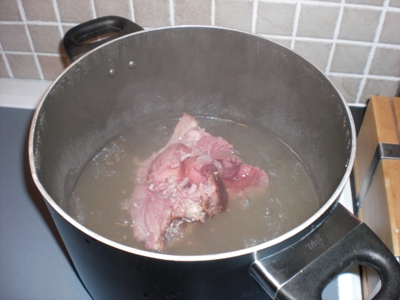
Photo: The sliced rutabaga added to the pan
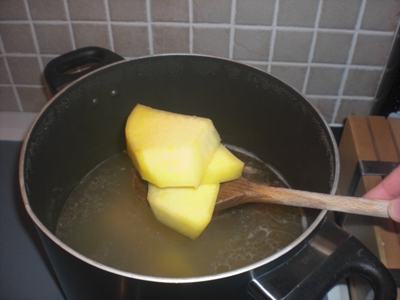
Photo: The milk has been added - nepespa nearly ready
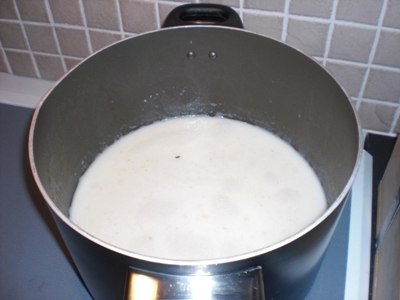
Photo: Dinner is ready!
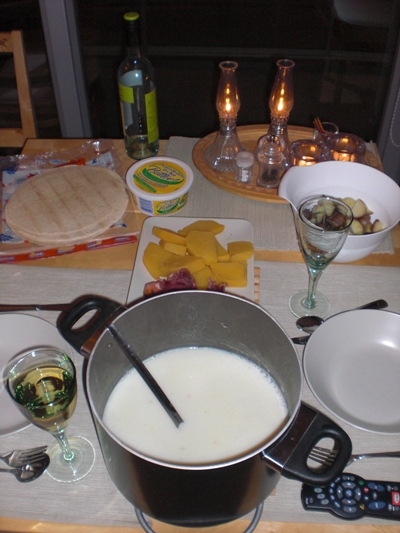
Posted by: Hild @ 6:03 pm
Initially our plan was to make calzone pizza, but then we remembered last time we made those. We made way too big calzones and ate them all…. piglets. So here is an option for a smaller dinner - maybe…
Ingredients (see also ‘Skulebrød’ - http://namnam.rygnestad.net/?p=28)
Dough for 6 horns:
- 20 grams butter (could also use 1/4 dl oil)
- 2.5 dl water (could also be milk)
- 1 rounded teaspoon dry yeast
- 1/2 teaspoon salt
- 1 teaspoon sugar
- ca. 6-7 dl of plain flour
- A little bit of milk for brushing
We like to not fill 2 horns and keep them for “afters” so - Filling for 4 horns (use whatever you’d like):
- 1/2 canned ham = 225 grams - chopped
- 3 rings of pineapple - drained well
- 1/4 red pepper - chopped
- 1/4 yellow pepper - chopped
- 12 table spoons cottage cheese (3 per horn) - drained well
Directions:
Follow the directions from ‘Skulebrød’ until the dough has risen once to approximately twice its original size. Divide the dough in two halves and roll it out. Cut three triangles from each half. Put some ham, pineapple, pepper, and cottage cheese at the wide end of each triangle. Fold the corners of each triangle around the filling and roll it up toward the pointy end of the triangle. [I know that this is cryptic - but the end result should look like a horn…]
Put the horns on a baking tray covered in aluminium foil and/or sprayed with oil. Cover the horns with a tea-towel and leave them to rise another 10-15 minutes. Turn on the oven and set it to 225 celsius. Bake the horns for 20-25 minutes in the middle of the oven.
Before serving, leave the horns on a rack to cool down. We ate them too soon and burned our mouths.
[This is where I would have added before- and after-photos, but the shutter speed on our camera is no match for Rob’s hunger. The horns were all gone before I could get a photo…. see: here is the empty plate!!]
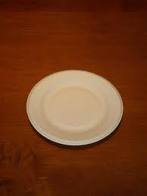
Posted by: Hild @ 6:53 pm
After a mini-holiday skiing in Mont-Tremblant, Quebec, we were inspired to buy a crepe maker. We were inspired after having two meals at Crêperie Catherine - dinner one day and returning the next day for dessert. We had front-row seats to see how the crepes were made in their little kitchen. To a Norwegian, a crepe maker is simply a small “takke” on which we make lefse (see recipe for hardangerlefse). We also predict many other uses for a crepe maker including making quesadillas or simply warming up tortillas filled with all sorts of goodness. That would be more interesting than sandwiches, for sure!
Crepe ingredients - Alternative 1 (UK/Delia crepes):
-
6 oz plain flour
-
a pinch of salt
-
2 large eggs
-
7 fl oz low-fat milk
-
3 fl oz water
Crepe ingredients - Alternative 2 (crepe recipe - came witht he crepe maker):
-
2 1/4 cup flour
-
1 teaspoon salt
-
(1 tablespoon sugar)
-
1 egg
-
1 cup water
-
1 1/3 cup low-fat milk
Crepe ingredients - Alternative 3 (Norwegian pannekaker):
-
ca. 3.5 dl flour
-
2 eggs
-
6 dl low-fat milk
-
1 teaspoon salt
-
(1-2 teaspoons sugar)
-
(1 tablespoon margarine or butter)
Mix the eggs, milk and water gradually to the flour and salt.
Avoid getting a lumpy batter. If you are unlucky (like we frequently are), simply strain the batter before cooking the crepes. Heat up the crepe maker (our brand needs mark 4-5). Put sufficient amount of batter to the middle of the crepe maker and use a crepe-scraper to spread the batter in a smooth and circular motion. We are still applying the trial-and-error method to determine how much batter and how to spread it evenly…. simply eat the errors. Cook the crepe 10-15 seconds on each side. Flip the crepe back to the first side and add filling as you like.
Some of the crepe fillings that we’ve tried:
-
Sliced/chopped ham, grated swiss cheese, a dash of maple syrup, freshly grated pepper
-
Peeled/sliced sweet apples, thinly sliced brie, a dash of maple syrup, freshly grated pepper
-
1 beaten egg, sliced/chopped ham, grated cheese
-
Ricotta cheese, handful of fresh baby spinach, freshly grated pepper
-
Ricotta cheese, peeled/sliced sweet apples, a dash of maple syrup (this one got a bit too soggy!)
-
Italian meatballs, fresh mozzarella cheese, tomato sauce (e.g. Prego)
-
Slices of steamed salmon, peas, sweet corn, tzatziki sauce
-
We haven’t tried sweet ones yet, but we’re picturing chocolate sauce, bananas, berries, manchar…. nam nam
We prefer to put the filling in the middle of the crepe and fold in the sides twice to make an envelope. This crepe-envelope can be flipped over and cooked/heated on both sides. For easy taste testing with family and friends we have loaded the filling down the middle of the crepe and folded over once to slice it up in several pieces.
I’m sure we’ll think of more ways of doing this as just about everything we eat now ‘goes’ past the crepe maker!!!
Some photos: (1) Rob adding batter to the crepe maker. (2) Ham and cheese filling. (3) Apple, brie and maple syrup
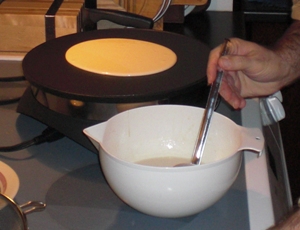
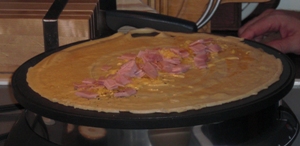
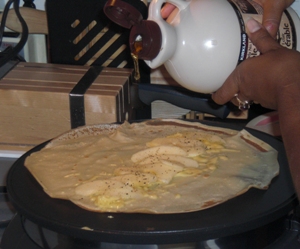
Posole
Here is how to make a Nam Nam (yummy) soup with great tasting stock, tender pork and fresh vegetables.
1. Mix the following ingredients in a large pot.
· 1.5 to 2 pounds of pork shoulder or roast
· 2 to 3 cups of canned or fresh hominy, rinsed
· 3 to 5 cloves of garlic
· 2 teaspoons salt
· 6 cups water or stock
2. Bring to a boil over medium-high heat, and then reduce heat to low and simmer for 1.5 to 2 hours, or until the meat is very tender.
3. Remove the pot from heat. Take the pork from pot and set aside to cool. When cool enough to handle, remove the meat from its bones and shred it with your hands.
4. Add the meat back to the pot and simmer for another 10 to 15 minutes. Adjust seasoning and serve with little bowls of your choice of garnishes so each diner can garnish his or her own serving.
5. Garnishes:
· Cabbage or iceberg lettuce, shredded
· Onion, finely diced
· Radishes, thinly sliced
· Limes, cut into wedges
· Avocado, diced
· Oregano, dried
· Chile piquín, ground
Source: www.whats4eats.com